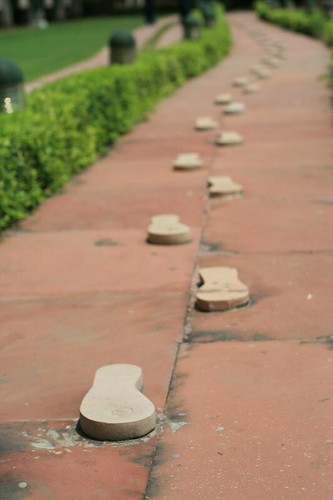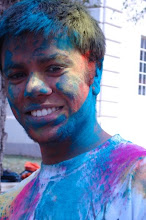Blog Archive
Tuesday, March 18, 2008
Stands Tall and Fights
I sit across this comfortable couch,
detach my i-pod, mute my machine
and do my beads.
And every bead that passes through my fingers
is accompanied with a prayer,
one that I had forsaken for long
but now I chant away.
I reach the last bead and open my eyes,
and see her shift under that blanket
a soft red blanket with white snowflakes
And it reminds me of January, last.
Had it really snowed ? In Austin ?
The roads were glazed over, as if
a sheet of ice had stopped over
and now lay expecting the worst
from this unusual place.
She insists on sleeping on the floor
the couch is too soft,
and the bed stays empty next door.
Like always, I relent without much resistance
Has it always been like this ?
Certainly never as confusing.
I detest to see any small thing hurt her,
but dont see much I could do
I hate to see her pay for things
yet I haven't the courage to stop her from it
I hate leaving her company for long
but dare not suffocate her.
And through these times,
every time I fall within her circle of life
say, while walking her to and fro,
If I even momentarily fall under the impression
that I am protecting her,
the next instant makes me laugh at myself.
Like Achilles needed his armor !
My mind which often is at ease
kneels down before my memory
that ruthlessly berates my senses,
but with nothing more than silence can afford.
I recollect that bright smile,
when standing at the front desk,
she was to receive some delicious food,
sent across from miles away,
fondly packed by motherly love,
love that smelt of home.
And now as she collects her own belongings
from hands that act as go-between.
Love seems to stand in a pool of shame.
And I see that same smile.
It most certainly is broader,
yet wait, has it become wanner?
She walks down 22nd beside me,
the afternoon sun beats down on us
But even in all his sternness I can see the pretence,
I can recognize that proud fatherly smile.
Yes, she stands tall and fights.
Friday, March 14, 2008
Winter of 2005 (An Ode to Chandigarh)

It's funny,
I've almost felt the touch-down,
and the endless rally with Time,
testing my will, to see how far away,
I could reach out from her lap.
But every time I've turned around,
That forlorn road, that despicable distance,
It has seemed so hard to simply crawl back,
the shameful, whimsical home-coming.
And now that my caprice has become a habit,
Fainly do I realize her grace,
Solemnly they proclaim her as 'City Beautiful',
For me she is an angel incarnate.
(My apologies if I've referred to the city in the wrong gender but you would surely excuse my natural dispositions. Isn't it?)
Thursday, March 13, 2008
Revival of Passive Resistance in Indian Commercial Cinema

What began as Mohandas Karamchand Gandhi's Non-Cooperation movement in colonial India , almost a century ago is, today, regarded as one of the most effective ways of achieving political or social goals. Whether it is the African-American Civil Rights Movement or the anti-apartheid movements in South Africa , various nations and communities have adopted the idea of passive resistance in achieving their respective socio-political objectives.
I met a drunken man this summer on the No. 5 bus. From the moment he entered, he looked totally smashed and there was no reason why I should have paid any attention. So, there I was, wearing that sophisticated student look and pretending not to be aware of his presence in a small, empty bus. That was until he drew up next to me and in a meek voice asked me if he could use my cell phone. For those of you who know nothing about me, it would be difficult to explain why I handed him the phone but what followed was horrific. He called up whomever and left one of the most foul, abusive voice messages I have ever heard. What was startling was that once he was done, he was very apologetic. He said something like the following:
“Thanks, man! I apologize. Look man, I'm really sorry … You're from India , right? …. (I nodded) You people in India like peace, right? Man, I totally know what you are thinking …. But you must understand …. I am a peaceful guy, I want peace … but this person …. this person is the biggest ***** …. and I believe in Karma and I believe in peace and I believe in non-violence too …. but she doesn't. She doesn't care and if she calls you back ….”
So, we as Indians have an image; one that isn't too distant from our cultural background. That non-violence is an integral and a much respected part of our culture, however, seems to have slowly escaped our memory. We as a community are full of so many religious or ethical beliefs, yet this one ethical lesson that we taught the world seems to have deactivated in our own minds.
For every culture there exist mirrors that not only reflect but also affect them on a whole. One such prominent cultural artifact is the film. Apart from being a visual art form and a source of entertainment, films also carry the responsibility of informing and educating. Immediately after Independence in 1947, a lot of the focus was on building – infrastructure, a national identity and so on. Not surprisingly, a lot of the cinema (minus the romancing and singing) was about perseverance and what I'd like to include in the scope of passive resistance. Traditional values and cultural celebrations formed the foundation of the conservative Indian cinema of that time. Mother India preached chastity even in the face of starvation, Do Ankhen Barah Haath delved into the possibility of reforming and rehabilitating corrupt minds through hard work while Ab Dilli Dur Nahin depicts the journey of a laborer's son to Pt. Nehru's residence in New Delhi in search of justice.
There are more reasons than can ever be listed by my feeble mind that forced a different path to successful cinema – commercially successful cinema. Stretch your memory back to the 70s, 80s or 90s and consider how much it mattered to you what the “hero-heroine-villain” combination in every movie was. At times, it was all that drove people to the theatres. Look at Amitabh Bachchan's early career as a gauge. Zanjeer, Deewar , Shahenshah, Sholay , Amar Akbar Anthony etc. a distinct pattern is discernable. The angry young hero(s), the gorgeous, distressed, troubled heroines, their arrogant/ ascetic parent combinations, the steering-swirling car chases, the exploiting industrialist, his blood-thirsty pets, the endless number of hired goons, and the two dozen songs. But, more importantly, the ideology that by pinning down fifty-odd henchmen, and blowing away the evil axis, the “hero” was doing the ultimate good worth applauding and idolizing, resonated in every film.
It seems that modern film-makers (a considerable few) perceive that the overused formulas have begun earning the viewers' ire. Most of them have themselves, in all probability, held similar views. More importantly, for the purpose of this article, they have begun incorporating once again, that aspect of our culture that seemed to have been bartered for box-office success. From the simple approach of Swades in exploring solutions to local problems to Lage Raho Munnabhai 's active application of ‘satyagraha' (referred to as Gandhigiri by the protagonist), there is an effort to remind citizens that there is strength in resistance without the use of violence. On receiving Best Actor's Award for Black , Amitabh Bachchan was quoted stating that “all credit to Sanjay (Leela) Bhansali and to the audience for embracing this piece of art. It is unique for a film to score with both critics and the audience. The success of Black shows the maturity of our audiences. A film like this demolishes the wall between art and commercial films. Really, Black has bridged many gaps. And that's so wonderful”. There might still be a stiff fight from historical sketches like Mangal Pandey , The Legend of Bhagat Singh or even those that depict a political uprise in modern settings like Rang De Basanti but there is discernable effort being made to wrap in every movie a message of a better alternative.

